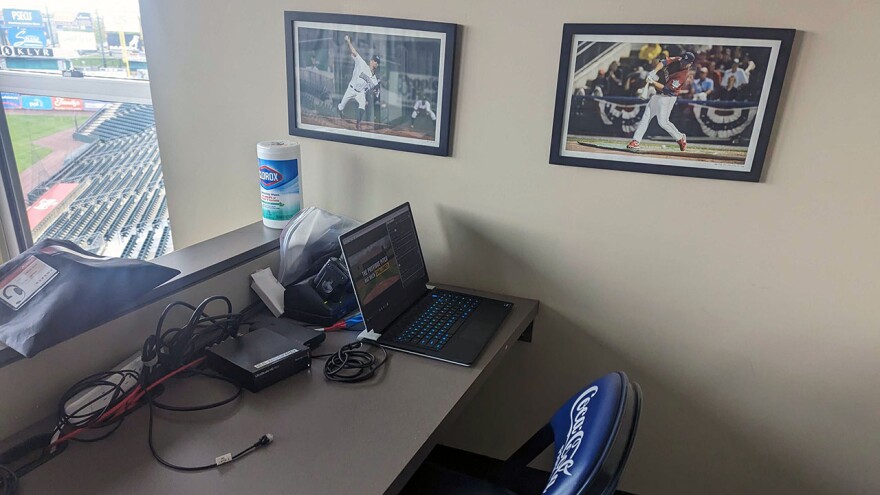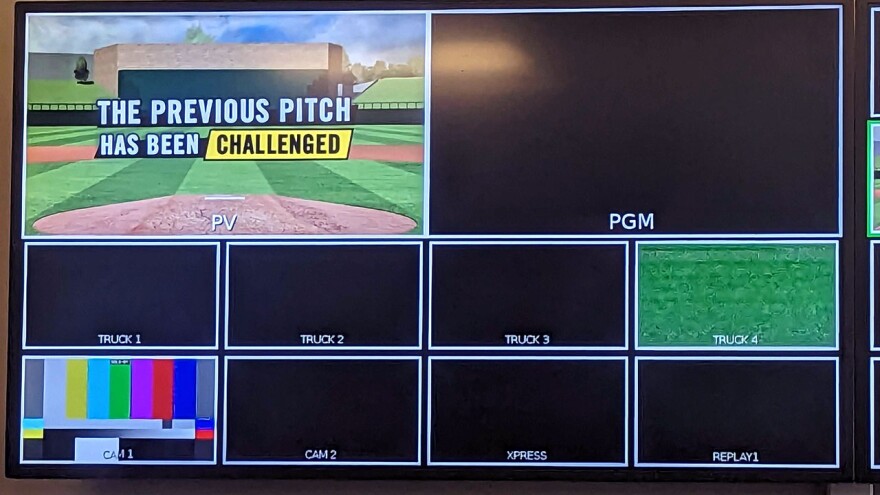ALLENTOWN, Pa. — It won’t look like WALL-E, Rosie or R2-D2. In fact, nothing resembling a robot will be on the field this season at Coca-Cola Park.
But if all goes according to plan, one of baseball’s biggest changes taking place behind the scenes will leave fans none the wiser.
For the first time in Allentown, and across Triple-A ballparks nationwide, the home plate umpire will be told through an earpiece whether each pitch is a ball or a strike.
- The automated balls and strikes system will debut Tuesday at Coca-Cola Park
- Triple-A teams will use the system in home games Tuesday through Thursday, and the challenge system during games Friday through Sunday
- The rollout and use of the ABS system will help Major League Baseball validate if the technology is able to make and communicate the correct call to the umpire quickly enough to not have a delay on the field
In other words, he won’t be able to call it the way he sees it.
It might be the future of umpiring not only at this level, but also at the Major League level.
It’s all part of the automated balls and strikes, or ABS, system — commonly referred to as “robot umpires” — that quietly rolled out at the end of April.
The Lehigh Valley IronPigs will be hosts for the Memphis Redbirds on Tuesday with the ABS system in use for the first time at home, and the hope is that fans won’t notice anything different going on, even as artificial intelligence continues to infiltrate America’s national pastime.
How the ABS system works
Take a stroll around the concourse at Coca-Cola Park and it’s easy to spot the white cameras trained toward home plate.
There are at least a dozen that will help triangulate a precise measurement of the strike zone, which is a 19-inch, two-dimensional rectangle set at 27% and 51% of the batter’s height (the knees to the middle of the chest).
During spring training, Major League Baseball measured every player for an accurate height for what they plugged into the system to get the exact parameters for the strike zone.
Hawk-Eye Innovations, the Sony group company that also powers MLB Statcast, considers all of it “a truly disruptive force in sport,” according to its website. It includes calibration technologies for ball tracking and has been used in Minor League baseball at the lower levels for a couple of years.
If any part of the ball touches the strike zone, the pitch will be called a strike. If it’s outside the strike zone, it’s a ball.

The ABS operator — positioned in a room adjacent to the press box above home plate — will track the pitches and radio the call to the home plate umpire through the earpiece.
The umpire then will signal a ball or strike — hopefully with very little delay.
“So, in actually calling the game I noticed [a small delay], just because I got used to the rhythm of, ‘Here’s the 2-1 pitch, top of the mitt, strike one called.’ Now it's, ‘Here’s your 2-1 pitch, top of the mitt’ and about a half-second" goes by, Sam Jellinek, the IronPigs’ play-by-play announcer, said.
Jellinek and the rest of the staff got acquainted with the ABS system when the IronPigs played a six-game series in Jacksonville at the end of April.
“The fully automated strike zone seems like it was pretty good,” Jellinek said. “There were a couple of calls here and there where guys had a little cockeyed look or whatever. But for the most part, it felt like it was fairly accurate.”
For the most part, it felt like it was fairly accurate.IronPigs play-by-play announcer Sam Jellinek, on the ABS system
The automated system will be used in games played Tuesday through Thursday at Coca-Cola Park, and will help Major League Baseball gather data and feedback from players, coaches and managers, according to a league official with direct knowledge of the program.
It’s unknown if use of the ABS system will reach the Major League level in 2024, though MLB Commissioner Rob Manfred signaled that intent during an interview with ESPN last summer.
“The testing of ABS in the minor leagues is part of a larger ongoing effort to provide fans with a more entertaining game," said Morgan Sword, executive vice president of baseball operations for Major League Baseball, in a statement provided to LehighValleyNews.com.
"There are several important questions about how best to deploy this powerful technology that remain unanswered at this point. We hope to use this season’s test at Triple-A to make progress on those questions in a highly competitive environment.”
Major League Baseball denied requests to speak with umpires about the system, which alters roughly seven to 10 years for how they’ve trained and prepared for the job to get to the Triple-A level.
“Eventually there will be one call where the umpire is told one thing in his ear, but reflexively does something else,” Jellinek said. “So, you know, I hope we never see that. But that'll be something interesting to keep an eye on.”
The challenge system
One of the biggest changes at the ballpark fans will notice will happen when the ABS system isn’t in use.
That’s because games played Friday through Sunday at Coca-Cola Park will now include the challenge system. During those games, umpires will call balls and strikes on their own and without use of the ABS system. But teams will be allowed to challenge those calls, with a limit.
Each team will be allowed three challenges per game (typically signaled by a player tapping his head), but they must be initiated by the pitcher, catcher or hitter.
If a team wins the challenge, it retains the challenge and it doesn’t count against the number available the rest of the game.
In theory, it means a team could have an infinite number of challenges if they keep winning them.
The interactive element for fans will be seeing a replay of the pitch on the video board in the outfield at the same time as the players and umpires.
“So you kind of get that anticipation of, you know, of the video showing up on the screen,” Jellinek said.
“And then, you know, the pitch comes home and it literally tracks it all the way from the pitcher's hands. You see it come all the way into the strike zone, so that’s pretty neat.”
It will be getting the process started in a timely manner that might trip up some players.
“You have a two-second window [to make a challenge] and you can't get any input from the dugout,” Jellinek said, noting a challenge could be negated if a player looks for help from teammates.
“It’s only going to be you in that moment.”
‘The rules are always adjusting’
From Jellinek’s observation, the challenge system has the potential to add to the on-field excitement — if the players are using it.
That series in Jacksonville, "players seemed pretty reluctant to use it,” he said. “Just from the standpoint of I think most of them are scared that they’re going to use a challenge in that spot where it ends up not mattering.

“The other part of it is, you know, it’s not like the NFL, where when you're challenging a play or even instant replay in Major League Baseball, where you have somebody on the phone telling you, ‘Hey, you should challenge this.’”
It means players will have to be judicious with their challenges, keeping in mind how many already have been used and overall situational awareness. Is it worth using it in the second inning of a game if you think you might need it in the seventh or eighth inning?
Time will tell how a strategy factors in.
The rollout also comes at a time when many of the MLB’s rule changes already have been tested at the Minor League level, including the new pitch clock, bigger bases, defensive shift limits and more.
IronPigs Manager Anthony Contreras may have summed it up best when asked about the ABS and challenge system the week the season started.
“It’s going to be interesting,” he said. “Because the rules are always adjusting.”
EDITOR'S NOTE: LehighValleyNews.com is a media sponsor of the Lehigh Valley IronPigs.





